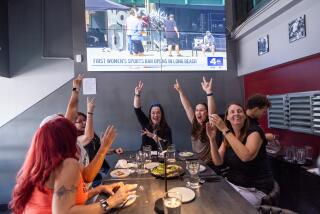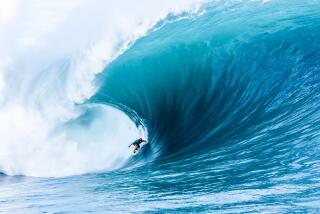MELTING THE ICE : Pro Beach Hockey, which debuts today at the Huntington Beach Pier, features several gimmicks, including ramps behind the goals, but the price is right: it’s free to watch
- Share via
The idea smacked concert promoter David McLane like a hockey puck between the eyes.
Driving through Beverly Hills, his car ran over a small, brightly colored ball that two young boys had been slapping around the street with hockey sticks.
Eight years and a couple detours later, McLane got the ball rolling again in Huntington Beach, where Pro Beach Hockey, his glitzy $2-million venture billed as a hockey-meets-beach experiment, begins play today just south of the pier.
The games will be filmed each weekend through Memorial Day for showing on ESPN throughout the summer.
Organizers contend the modified hockey rules and flashy presentation will carve a niche with the X-Games crowd and beach-goers alike.
But some in the in-line industry believe Pro Beach Hockey may jeopardize the future of their sport, which is booming in suburban rinks with nearly 4 million participants but has had setbacks at the professional level.
“Maybe it will work, maybe it won’t,” said Maury Silver, founder of the Bullfrogs, a 5-year-old professional in-line team that he says has lost $2 million. “If it really works, I’ll put a team on Santa Monica Beach or Redondo Beach or somewhere else they want me. We’re all just watching to see what happens.”
When competition begins today in a specially designed rink, McLane intends to put on a spectacle not unlike the “Gorgeous Ladies of Wrestling” shows he produced for TV in the mid-1980s.
Six 11-man teams, with such names as Heavy Metal, Web Warriors and Gargoyles, will don uniforms, strap on skates with special chassis and bang each other around in front of 12 television cameras.
The city’s bicycle path has been connected to the rink by ramps and local skaters and bike riders will be encouraged to roll up to the bleachers to catch the action.
The rink--about a third smaller than the one at the Pond--can be seen from Pacific Coast Highway and is surrounded by bleachers with 2,000 free seats available on a first-come, first-served basis. At one end is a covered stage for concerts by alternative bands between games.
The city, which is redeveloping around its pier, is happy to have the event, Huntington Beach Community Services Director Ron Hagan said.
“We’re trying to enhance our tourism business,” he said. “We have changed from a predominantly agriculture/oil area to a bedroom community. For us to survive, we have to broaden our tax base. The Pro Beach entourage has its people filling up our hotel rooms and eating in our restaurants, and that’s good for business.”
Some in the roller hockey community also like the idea.
“While it’s not likely to appeal that much to elite amateur players or die-hard fans of professional in-line hockey, I think there’s a place for David McLane’s version,” said Richard Graham, former editor of Inline Hockey Magazine and current chief at Inline Hockey Central, an interactive website.
“It will appeal to kids and in-line hockey neophytes, and by being televised on ESPN, it will only bring visibility to our great sport. It’s not old-school hockey by any means, but I think it’s going to be a lot of fun to watch [on TV].”
Others disagree.
“You’ve got some good ingredients like being outdoors, and maybe this will have some success because it resembles pro beach volleyball,” said Paul Chapey, head of North American Roller Hockey Championships, the largest amateur in-line tournament series in the nation. “But as far as the game itself, you can do without so many gimmicks. It might be more like roller derby than hockey.”
It certainly has what other roller hockey leagues have been unable to get: TV time. The entire 35-game series will be taped and 26 one-hour programs are expected to be shown 81 times this summer on ESPN and ESPN2. The one-year cable deal has an option for two additional years if the ratings are good, McLane said. The package is also expected to be picked up on the cable giant’s 140-nation international programming channel for airing later this year.
McLane’s first attempt at promoting the sport was in 1993 with the World Roller Hockey League, another gimmick-laden TV production featuring 28 games that was filmed in Florida. It lasted one season.
McLane spent nearly four seasons as marketing director for Roller Hockey International, but when that league was dropped by ESPN because of poor ratings at the end of the 1996 season, McLane concentrated on his Pro Beach plans.
Neither McLane nor an ESPN spokesman would say how much the network has spent on Pro Beach. But ESPN’s Josh Krulewitz said the cable network has been looking for a “TV-driven” event for three years, since it created the X-Games, which return to San Diego next month.
“The X-Games and this event are both about competition,” Krulewitz said. “And live action will translate to television. Obviously, the network is involved in the production of this event, but the athletic performances in the rink will dictate the outcome.”
Pro Beach Hockey’s rules feature changes that organizers believe will make competition more exciting.
But roller hockey purists such as Chapey contend the changes are merely made-for-TV gimmicks that will never be adopted nationally.
For instance, there’s no puck. McLane’s little ball is back, although it’s now fluorescent green because it shows up better against the court surface on TV. Off-sides has been eliminated. Like basketball players who are awarded free throws for being fouled, penalties will result in a free shot on goal. There is also two-point goal line. End zone ramps behind the goals are designed to keep the ball in play and increase skating speed.
In practice this week, players were using the ramps to gain air behind the goal. Some of the more nimble skaters were reaching the top of the protective plexiglass sheets.
That’s higher than technicians who designed the ramps ever considered, McLane said. “I don’t know what to expect, particularly with that ramp,” said Andy Rymsha, a former minor league ice hockey player and RHI veteran who will skate for the Gargoyles. “But it appears to have its own identity. I think kids can relate to this, especially kids here on the West Coast.”
There will be a lot of contact, too. Players have been encouraged to check like ice hockey players. After all, said Pro Beach Commissioner Chris McSorley, hitting sells.
McSorley said he expects Pro Beach Hockey to resemble “putting eight marbles in a bowl and watching them go.”
With a little practice, players can play shots off the ramp that loop back in front of the net.
“Goalies will hate it, but this is the future of the sport,” McSorley said. “Roller hockey was meant to be played outdoors. We are creating a bridge between extreme skating and in-line hockey. All pro sports constantly review the structure of the rules of play and upgrade where needed to increase the entertainment value, and that is what we have done.”
Professional roller hockey has been the in-line Achilles’ heel. The new X-treme League was touted for start-up this summer on the East Coast, but it never got off the ground. RHI, which lasted five seasons and once boasted 24 teams in Canada and the United States, went broke at the end of last season and has announced it will not play this year while it attempts to reorganize.
“Professional roller hockey got off to a great start, but then faltered quickly,” said McSorley, the older brother of San Jose Shark defenseman Marty McSorley. “It doesn’t have a good identification stamp with the public due to the fact that it wasn’t user-friendly. It was slow and boring to watch a professional in-line game in a big arena.”
More than half of the Pro Beach players selected by McSorley, who coached the Bullfrogs to their first RHI championship in 1993, are minor league ice hockey players. More than 40 have RHI experience, said McSorley, who is also coach of the Las Vegas Thunder of the International Hockey League. Each player will earn a minimum of $500 and another $500 in incentives if a team does well.
McLane believes Pro Beach will attract 100,000 extra people to the beach during its four weekends of play. Games begin at 11 a.m. each day and end by 6 p.m. On weekdays he has scheduled free in-line seminars for local teams and tours for local schools.
McLane has paid the city $25,000 to run Pro Beach. That’s a bargain, Hagan said, because the exposure Huntington Beach expects to receive from the TV deal will be good for downtown businesses.
“What it does is market our city, particularly in the Pacific Rim markets,” Hagan said. “We get mentioned on every lead in and out and every commercial break. That kind of thing is an incredible value to us.”


